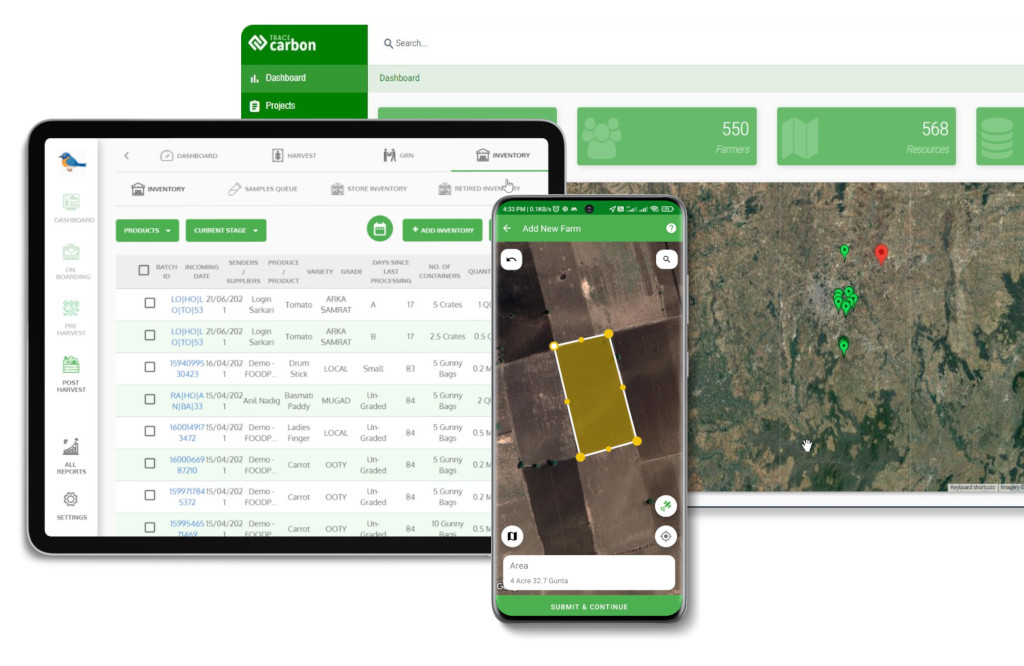Contact: +91 99725 24322 |
Menu
Menu
Quick summary: Discover how regenerative agriculture is transforming sustainable coffee farming, improving soil health, climate resilience, and biodiversity for a more sustainable coffee supply chain.

With the global demand for coffee steadily rising, coupled with the growing urgency of addressing climate change, coffee producers face increasing pressure to adopt sustainable coffee farming practices. Regenerative agriculture is emerging as a powerful solution to help the coffee industry not only meet these challenges but also thrive in a more resilient and eco-friendly way. By embracing regenerative agriculture, coffee farmers can enhance sustainability, restore ecosystems, and improve the long-term viability of coffee farming.
According to Enveritas, there are approximately 12.5 million coffee farms globally, with around 95% being smaller than 5 hectares and classified as ‘smallholder’. These farms are mostly situated in 20 countries that possess the ideal climate and soil conditions for coffee cultivation.
Traditional coffee farming practices have long been associated with significant environmental challenges. From soil degradation caused by monocropping and excessive use of chemicals to the overuse of water resources and the contribution to deforestation, the coffee industry is at a crossroads. These environmental issues threaten not only the future of coffee farming but also the entire coffee supply chain that relies on healthy ecosystems. By adopting regenerative methods, the coffee industry can enhance climate resilience, improve yields, and reduce its environmental footprint, ensuring that coffee remains a viable crop for generations to come.
Key Takeaways
Regenerative agriculture is an innovative approach to farming that focuses on rebuilding and revitalizing the land, rather than simply maintaining it. The core principles of regenerative agriculture include restoring soil health, enhancing biodiversity, managing water efficiently, and promoting carbon sequestration. By focusing on these aspects, regenerative farming works to create a more sustainable and resilient ecosystem. It’s not just about reducing the negative impact of farming; it’s about improving the environment and making it healthier for future generations. For coffee farmers, adopting regenerative practices can lead to healthier soil, better water management, and more resilient crops that can withstand the effects of climate change.
Conventional coffee farming often relies on chemical inputs, monocropping, and intensive land use, which can lead to soil depletion, reduced biodiversity, and water scarcity. In contrast, regenerative agriculture takes a more holistic approach. Instead of depleting resources, it seeks to replenish them. By using natural methods like cover cropping, reduced tillage, and composting, regenerative farming helps restore the soil’s fertility and structure. This is a stark contrast to conventional methods that can degrade the soil over time and lead to lower yields and increased vulnerability to pests and diseases. Regenerative practices not only improve the land but also make coffee farming more sustainable in the long run.
One of the key elements of regenerative agriculture is agroforestry, which involves planting trees alongside crops like coffee. Agroforestry in coffee farming can provide numerous benefits, such as improving soil health, providing shade, and reducing the need for chemical fertilizers. The trees help enhance biodiversity by creating habitats for various species, which in turn supports a balanced ecosystem. Additionally, agroforestry can help manage water more efficiently, as trees act as natural water regulators. Crop diversity, another important aspect of regenerative farming, also helps by reducing the risk of disease and pest outbreaks. By diversifying the crops grown alongside coffee, farmers can reduce their reliance on harmful pesticides and improve overall farm resilience.
In short, regenerative agriculture is a game-changer for coffee farming, focusing on the restoration of ecosystems and soil health. When combined with agroforestry and diverse cropping systems, it creates a more sustainable and resilient coffee supply chain that benefits both farmers and the environment.

One of the key benefits of regenerative agriculture is the improvement of soil health, which directly impacts coffee yields. Traditional coffee farming often leads to soil depletion, making it harder for crops to thrive. However, regenerative practices like cover cropping, composting, and no-till farming work wonders for soil fertility. Cover cropping helps prevent soil erosion and adds organic matter, while composting enriches the soil with essential nutrients. No-till farming, on the other hand, minimizes soil disturbance, allowing it to retain its structure and beneficial microorganisms. As a result, coffee plants grow in healthier soil, leading to better yields, stronger plants, and more flavorful beans. These practices not only boost productivity but also ensure that the land remains fertile and productive for years to come.
Regenerative agriculture is a powerful tool for enhancing climate resilience on coffee farms. Climate change is making coffee farming more unpredictable, with extreme weather events, fluctuating temperatures, and changing rainfall patterns becoming increasingly common. By improving soil structure through practices like composting and agroforestry, regenerative methods help coffee farms adapt to these changes. Healthy soils can better retain water, which helps plants survive droughts or irregular rainfall. Additionally, regenerative farming improves plant health by boosting biodiversity and creating a more resilient farming ecosystem. As coffee farms become more climate-resilient, they can withstand the stresses of climate change and maintain consistent production, even in the face of unpredictable weather.
Water scarcity is one of the biggest challenges faced by coffee farmers, especially in regions where water resources are limited or unreliable. Regenerative agriculture offers several solutions to help conserve water and improve its management. Techniques like rainwater harvesting allow farmers to capture and store rainwater for use during drier periods. Agroforestry, which involves planting trees alongside coffee crops, helps retain moisture in the soil and reduces evaporation. Additionally, practices like mulching and soil moisture retention techniques help the soil absorb and retain water more effectively, reducing the need for irrigation. These water-saving techniques not only help address water scarcity but also ensure that coffee plants receive the right amount of moisture, which is crucial for healthy growth and high-quality beans.
In conclusion, regenerative agriculture is transforming coffee farming by improving soil health, enhancing climate resilience, and optimizing water management. By adopting these practices, coffee farmers can grow more resilient crops, adapt to climate challenges, and produce higher-quality coffee while also protecting the environment for future generations.
Many organizations and technology providers offer training programs to teach farmers the principles of regenerative agriculture. These programs cover topics like soil health, water management, and agroforestry techniques, helping farmers understand the benefits and practices involved.
Additionally, financial incentives can help mitigate the costs of transition. Some governments, NGOs, and coffee brands offer grants or loans to farmers who are adopting sustainable and regenerative farming practices. These financial incentives can make it easier for farmers to cover the initial costs of new equipment, seeds, and labor.
Finally, technology platforms like TraceX can play a key role in simplifying the adoption of regenerative practices. TraceX offers real-time data and farm management tools that help farmers track their progress and optimize their farming practices. With TraceX, farmers gain access to technology that supports better decision-making and reduces the risk associated with transitioning to regenerative methods. The platform also helps farmers connect with buyers who are interested in sourcing sustainably grown coffee, creating new market opportunities for regenerative coffee.
TechnoServe’s ‘Sustainable Livelihoods for Smallholder Farmers’ program partnered with TraceX to enhance the consistency and quality of coffee production through sustainable farming practices. By leveraging TraceX’s blockchain-based traceability platform, the partnership ensured transparency in the coffee supply chain, allowing for the monitoring and verification of sustainable practices across all stages of production.
Coffee brands have an essential role to play in supporting regenerative practices, and it’s in their best interest to do so. As consumers become more conscious of the environmental and social impacts of their purchasing decisions, brands that invest in regenerative agriculture can differentiate themselves in the market. By partnering with farmers, cooperatives, and technology providers like TraceX, coffee brands can help drive the adoption of regenerative practices across the coffee supply chain.
One of the most powerful ways TraceX supports regenerative agriculture is through its blockchain-based food traceability platform. This platform allows coffee brands and consumers to track and verify every step of the coffee supply chain—from farm to cup. By recording each transaction on a secure, transparent, and immutable blockchain, TraceX ensures that regenerative farming practices are being followed across the entire coffee supply chain. Coffee brands can verify that their coffee is sourced from farms that are committed to regenerative agriculture, such as using cover crops, agroforestry, and composting. This level of traceability not only supports sustainable sourcing but also gives consumers confidence that their coffee is environmentally friendly and responsibly produced.
TraceX also uses satellite technology to provide real-time monitoring of land health, deforestation, and water use in coffee-growing regions. This cutting-edge technology enables coffee brands and farmers to keep a close eye on the environmental impacts of coffee farming practices. By using satellite imagery, TraceX can track deforestation rates, monitor soil health, and assess water usage, helping to ensure that regenerative practices are being implemented effectively. It also provides early warnings if there are signs of environmental degradation, enabling farmers and brands to take corrective action before issues escalate. This data-driven approach makes it easier for coffee brands to make informed decisions about their sourcing practices, ensuring that their coffee is grown sustainably and regeneratively.
In addition to supporting regenerative farming practices, TraceX helps coffee brands meet important regulatory requirements, such as the EU Deforestation Regulation (EUDR). The EUDR requires companies to prove that the products they import into the EU do not contribute to deforestation, and TraceX makes this process easier by providing clear documentation and traceability. By using TraceX’s EUDR platform, coffee brands can ensure that their coffee is sourced from deforestation-free regions and that their entire supply chain is compliant with EUDR regulations. This not only helps brands meet legal requirements but also aligns them with the growing consumer demand for sustainability and ethical sourcing.
TraceX’s farm management platform is another key tool in supporting coffee farmers who are transitioning to regenerative practices. This platform offers real-time data and insights that help farmers optimize their operations, improve productivity, and implement regenerative farming techniques. Farmers can access training on best practices for soil health, water management, and agroforestry, and they can track their progress as they adopt new methods. TraceX also helps farmers connect with financing options to fund their transition to more sustainable and regenerative farming. By empowering farmers with the right tools, data, and support, TraceX ensures that regenerative agriculture becomes a viable and successful option for coffee growers.
Regenerative agriculture is revolutionizing the coffee industry by addressing critical environmental, economic, and social challenges. With its emphasis on soil health, climate resilience, and biodiversity, regenerative practices offer a path toward a sustainable and prosperous future for coffee farmers. By adopting these practices, farmers not only improve their yields but also contribute to the long-term health of the planet. Coffee brands and consumers alike have a unique opportunity to support this transformation, creating a more sustainable coffee supply chain that benefits everyone—from farmers to consumers.
Regenerative agriculture focuses on practices like soil health restoration, agroforestry, and water management to improve long-term farm sustainability. For coffee farming, it enhances soil fertility, boosts resilience to climate change, and helps restore ecosystems.
Coffee brands can support regenerative agriculture by committing to purchasing sustainably grown coffee, investing in training for farmers, and implementing traceability platforms like TraceX to ensure ethical sourcing.
The main challenges include the initial cost of implementing regenerative practices, lack of training and knowledge among farmers, and limited access to markets for regenerative coffee. However, financial incentives, education, and technology solutions are helping overcome these barriers.
